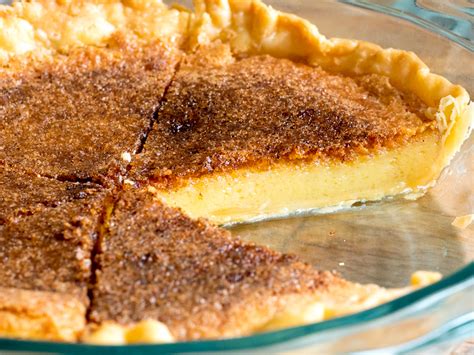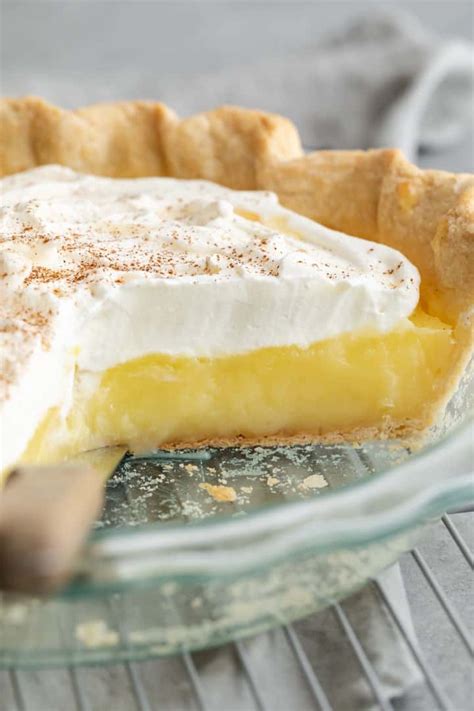
Iowa’s vinegar pie, a dessert with roots stretching back to the state’s pioneer era, is sparking debate among food enthusiasts, with some praising its unique sweet and tangy flavor while others remain unconvinced. This thrifty pie, born out of necessity when fresh fruit was scarce, relies on vinegar to mimic the acidic notes of fruit, offering a taste of history in every bite.
The vinegar pie, a humble concoction of vinegar, sugar, butter, and eggs, baked in a flaky crust, represents a culinary ingenuity that emerged from the resourcefulness of early Iowa settlers. Faced with limited access to fresh fruit, these pioneers ingeniously substituted vinegar to create a pie that offered a semblance of fruity sweetness. “It’s a really old recipe,” says food historian Sarah Lohman, “it comes out of a time when people didn’t have access to fresh fruit year-round.” This necessity-driven creation has become a symbol of the region’s heritage, offering a tangible link to the past.
While the pie’s historical significance is undeniable, its flavor profile has proven to be polarizing. The combination of sweet and sour notes, derived from the vinegar, can be an acquired taste. Some describe it as a delightful blend of sweet and tangy, reminiscent of lemon or apple pie, while others find the vinegar’s sharpness off-putting. This divergence in opinion has fueled an ongoing debate about the pie’s merits, with proponents championing its uniqueness and detractors questioning its palatability.
The revival of interest in vinegar pie can be attributed to a growing appreciation for historical recipes and a desire to reconnect with culinary traditions. As Lohman points out, these recipes offer a window into the lives and resourcefulness of past generations. Exploring these historical dishes not only allows us to taste the past but also provides valuable insights into the challenges and innovations of those who came before us. The vinegar pie, with its simple ingredients and compelling backstory, serves as a reminder of the ingenuity and resilience of early American settlers.
A Slice of History: Tracing the Origins of Vinegar Pie
The history of vinegar pie is deeply intertwined with the story of early American settlement, particularly in regions like Iowa where access to fresh produce was often limited. During the 19th century, as pioneers ventured westward, they encountered numerous challenges in establishing sustainable food systems. Transportation was slow and unreliable, making it difficult to obtain fresh fruits and vegetables, especially during the harsh winter months. In these circumstances, resourceful cooks had to rely on ingenuity and creativity to make the most of available ingredients.
Vinegar, a readily available pantry staple, emerged as a versatile substitute for fruit in various recipes. Its acidic properties could mimic the tanginess of fruits like apples, lemons, or berries, providing a much-needed flavor boost to otherwise bland dishes. Vinegar pie, in particular, became a popular dessert option, offering a sweet and tangy treat that could be made with minimal ingredients.
The earliest documented recipes for vinegar pie date back to the mid-19th century, appearing in cookbooks and household manuals of the time. These recipes typically called for a combination of vinegar, sugar, butter, eggs, and spices, all baked in a flaky pie crust. The type of vinegar used could vary, with apple cider vinegar being a common choice due to its mild flavor and readily availability.
Over time, vinegar pie became a regional specialty, particularly associated with the Midwest and other areas with strong pioneer roots. It was often served during holidays and special occasions, representing a taste of home and a connection to the past. While the pie may have faded from mainstream popularity in recent decades, it has experienced a resurgence of interest in recent years, thanks to the efforts of food historians, chefs, and home cooks who are eager to preserve and celebrate traditional American cuisine.
The Recipe: Unpacking the Ingredients and Preparation
The beauty of vinegar pie lies in its simplicity. The recipe typically calls for just a handful of readily available ingredients, making it an accessible option for home cooks of all skill levels. Here’s a breakdown of the key components and preparation steps:
- Crust: A flaky pie crust is essential for a good vinegar pie. You can use a store-bought crust for convenience, or make your own from scratch using a classic recipe of flour, butter, salt, and water.
- Vinegar: The type of vinegar you use will significantly impact the flavor of the pie. Apple cider vinegar is a popular choice for its mild, fruity notes. White vinegar can also be used, but it will result in a more tart and tangy flavor. Some recipes also call for malt vinegar or even balsamic vinegar, depending on the desired flavor profile.
- Sugar: Sugar is crucial for balancing the acidity of the vinegar and creating a sweet and palatable dessert. The amount of sugar can be adjusted to taste, depending on your preference for sweetness.
- Butter: Butter adds richness and flavor to the filling, creating a smooth and creamy texture. Melted butter is typically used in vinegar pie recipes.
- Eggs: Eggs act as a binder, helping to thicken the filling and create a custard-like consistency. They also add richness and flavor to the pie.
- Spices: Spices like cinnamon, nutmeg, and cloves are often added to enhance the flavor of the pie. These spices complement the vinegar and sugar, creating a warm and inviting aroma.
The preparation of vinegar pie is relatively straightforward. First, the crust is prepared and placed in a pie dish. Then, the filling is made by whisking together the vinegar, sugar, butter, eggs, and spices in a bowl. The filling is poured into the crust, and the pie is baked in the oven until the crust is golden brown and the filling is set.
While the basic recipe for vinegar pie remains consistent, there are countless variations and adaptations. Some recipes call for the addition of cornstarch or flour to thicken the filling, while others add lemon juice or zest for extra flavor. Some cooks also experiment with different types of vinegar or spices to create their own unique variations.
A Culinary Debate: Sweet vs. Sour – The Flavor Divide
The flavor of vinegar pie is undeniably unique, and it’s this very uniqueness that has sparked a culinary debate among food enthusiasts. For some, the combination of sweet and sour notes is a delightful and intriguing experience, reminiscent of classic desserts like lemon meringue pie or apple pie. They appreciate the pie’s tangy edge, which provides a refreshing contrast to the sweetness.
“It’s surprisingly good,” says one vinegar pie enthusiast. “The vinegar adds a subtle tang that balances the sweetness perfectly. It’s not like anything else I’ve ever tasted.”
However, not everyone is a fan of vinegar pie’s distinctive flavor. Some find the vinegar’s sharpness overpowering, describing it as an unpleasant or even off-putting taste. They may find the pie too sour or too tangy, lacking the comforting sweetness of more traditional desserts.
“I just couldn’t get past the vinegar flavor,” admits one vinegar pie skeptic. “It tasted like someone had accidentally poured vinegar into a perfectly good pie. It was just too sour for my liking.”
The debate over vinegar pie’s flavor highlights the subjective nature of taste. What one person finds delicious, another may find unpalatable. Factors like personal preferences, cultural background, and past experiences can all influence our perception of flavor. While some may be drawn to the pie’s unusual combination of sweet and sour, others may prefer the familiar comfort of more traditional desserts.
Vinegar Pie in Modern Cuisine: A Resurgence of Interest
Despite its polarizing flavor, vinegar pie has experienced a resurgence of interest in recent years. This revival can be attributed to several factors, including a growing appreciation for historical recipes, a desire to reconnect with culinary traditions, and a fascination with unique and unusual foods.
Food historians and chefs have played a significant role in promoting vinegar pie and other traditional American dishes. By researching and documenting these recipes, they have helped to preserve them for future generations. They have also introduced these dishes to a wider audience, showcasing their historical significance and culinary value.
“It’s important to remember where our food comes from,” says Chef John Shields, a renowned expert on Mid-Atlantic cuisine. “These traditional recipes tell a story about our history and our culture. They’re a valuable part of our heritage.”
The rise of the farm-to-table movement has also contributed to the renewed interest in vinegar pie. As consumers become more conscious of the origins of their food, they are increasingly drawn to recipes that celebrate local and seasonal ingredients. Vinegar pie, with its simple ingredients and connection to the land, fits perfectly into this trend.
In addition, the growing popularity of food blogs and social media has helped to spread the word about vinegar pie. Home cooks and food enthusiasts are sharing their recipes and experiences with the pie online, inspiring others to try it for themselves. This online buzz has helped to create a sense of community around vinegar pie, connecting people who share a passion for this unique and historic dessert.
Today, vinegar pie can be found on the menus of some restaurants and bakeries, particularly in regions with strong pioneer roots. It is also a popular item at farmers’ markets and food festivals, where it is often sold alongside other traditional American treats. While it may not be a mainstream dessert, vinegar pie has certainly carved out a niche for itself in the culinary landscape, offering a taste of history and a reminder of the ingenuity and resilience of early American settlers.
The Enduring Appeal: Why Vinegar Pie Still Matters Today
Despite its polarizing flavor and humble origins, vinegar pie continues to hold a special place in the hearts of many. Its enduring appeal lies in its ability to connect us to the past, to remind us of the resourcefulness and resilience of our ancestors, and to offer a unique and intriguing culinary experience.
Vinegar pie is more than just a dessert; it’s a symbol of American history and culture. It represents the ingenuity and creativity of early settlers who had to make the most of limited resources. It’s a reminder of the challenges they faced and the sacrifices they made to build a new life in a new land.
By preserving and celebrating vinegar pie, we are honoring the legacy of these pioneers and keeping their stories alive. We are also celebrating the diversity and richness of American cuisine, showcasing the unique flavors and traditions that have shaped our culinary identity.
In a world of mass-produced and homogenized foods, vinegar pie offers a refreshing alternative. It’s a handmade dessert that is made with simple, wholesome ingredients. It’s a taste of authenticity and a reminder of the importance of preserving traditional culinary practices.
Whether you love it or hate it, vinegar pie is a dessert that sparks conversation and invites reflection. It’s a reminder that food is more than just sustenance; it’s a cultural artifact that can tell us a lot about ourselves and our history. As long as there are those who are willing to embrace its unique flavor and appreciate its historical significance, vinegar pie will continue to be a part of the American culinary landscape.
Beyond Iowa: Vinegar Pie’s Presence in Other Regions
While often associated with Iowa and the Midwest, vinegar pie’s presence extends beyond these regions, reflecting the widespread nature of pioneer life and the resourceful adaptations of early American cooks. Wherever settlers faced challenges in accessing fresh fruit, the ingenuity to create a substitute like vinegar pie took root.
In Appalachia, for instance, vinegar pie held a similar significance. Mountain communities, often isolated and with limited access to transportation, relied on resourcefulness to create satisfying meals. Vinegar, readily available due to its use in pickling and preserving, served as a vital ingredient in desserts. Appalachian vinegar pie recipes often incorporated local variations, such as the addition of sorghum molasses for extra sweetness or the use of wild berries for a hint of fruit flavor where available.
Similarly, in the Southern United States, vinegar pie found its place in the culinary repertoire. While fresh fruit was more readily available in some parts of the South compared to the Midwest or Appalachia, vinegar pie still served as a thrifty and reliable dessert option, particularly during times of hardship or when specific fruits were out of season. Southern versions of vinegar pie sometimes included additions like lemon zest or a splash of bourbon for added flavor complexity.
The Pennsylvania Dutch region also boasts its own unique take on vinegar pie. Known for their culinary traditions and resourceful cooking methods, the Pennsylvania Dutch incorporated vinegar into a variety of dishes, including desserts. Their vinegar pie recipes often featured a combination of sweet and sour flavors, with the addition of spices like cinnamon and cloves to create a warm and aromatic filling.
The widespread presence of vinegar pie across different regions of the United States underscores its importance as a staple in early American cuisine. It reflects the resourcefulness and adaptability of pioneer cooks who were able to create delicious and satisfying desserts even in the face of limited resources. While regional variations exist, the basic concept of using vinegar to mimic the flavor of fruit remains consistent, highlighting the shared culinary heritage of early American settlers.
The Psychology of Taste: Why We Love or Hate Vinegar Pie
The intense debate surrounding vinegar pie’s flavor raises interesting questions about the psychology of taste and why we perceive certain flavors as pleasurable while others are off-putting. Taste perception is a complex process influenced by a variety of factors, including genetics, cultural background, personal experiences, and even our emotional state.
Genetics play a significant role in determining our sensitivity to different tastes. Some people are genetically predisposed to be more sensitive to bitter or sour flavors, while others are more tolerant. This genetic variation can explain why some individuals find the tanginess of vinegar pie appealing, while others find it overpowering.
Cultural background also shapes our taste preferences. The foods we grow up eating and the culinary traditions we are exposed to influence our expectations and associations with different flavors. In cultures where sour or tangy flavors are commonly used in desserts, people may be more likely to appreciate the taste of vinegar pie. Conversely, in cultures where sweet flavors dominate desserts, the tanginess of vinegar pie may be perceived as unusual or even unpleasant.
Personal experiences also play a role in shaping our taste preferences. Positive experiences associated with a particular food can create a positive association, making us more likely to enjoy it. Conversely, negative experiences, such as getting sick after eating a certain food, can create a negative association, making us less likely to want to eat it again.
Our emotional state can also influence our taste perception. When we are feeling stressed or anxious, our taste buds may become more sensitive, making us more likely to perceive bitter or sour flavors as unpleasant. Conversely, when we are feeling relaxed and happy, our taste buds may become less sensitive, allowing us to enjoy a wider range of flavors.
The unique flavor profile of vinegar pie, with its combination of sweet and sour notes, can trigger a variety of different taste perceptions depending on individual preferences and experiences. For those who are genetically predisposed to enjoy sour flavors, or who have positive associations with tangy desserts, vinegar pie can be a delightful and intriguing treat. However, for those who are more sensitive to sourness, or who prefer sweeter, less complex desserts, vinegar pie may be a less appealing option.
Ultimately, the question of whether we love or hate vinegar pie comes down to a complex interplay of genetics, culture, personal experiences, and emotional state. There is no right or wrong answer, and individual preferences will always vary. However, understanding the psychology of taste can help us to appreciate the diversity of culinary traditions and to explore new and interesting flavors with an open mind.
Modern Adaptations: Reinventing Vinegar Pie for Today’s Palate
While traditional vinegar pie recipes hold a special place in culinary history, modern chefs and home cooks are constantly experimenting with new ways to adapt and reinvent this classic dessert for today’s palate. These adaptations often involve incorporating new ingredients, techniques, or flavor combinations to create a more contemporary and appealing version of vinegar pie.
One common adaptation is to use different types of vinegar to create more complex and nuanced flavor profiles. While apple cider vinegar remains a popular choice, some chefs are experimenting with other vinegars, such as balsamic vinegar, rice vinegar, or even fruit-infused vinegars, to add unique notes of sweetness, acidity, or aroma.
Another adaptation is to incorporate fresh fruit or fruit purees into the filling. This can help to balance the tanginess of the vinegar and create a more balanced and harmonious flavor profile. Some recipes call for the addition of apples, berries, or even citrus fruits to complement the vinegar and add a touch of natural sweetness.
Modern vinegar pie recipes also often feature more sophisticated spice combinations. While traditional recipes typically rely on cinnamon, nutmeg, and cloves, some chefs are experimenting with more exotic spices, such as cardamom, ginger, or star anise, to add depth and complexity to the filling.
In addition to changes in ingredients, modern adaptations of vinegar pie also often incorporate new techniques to improve the texture and appearance of the dessert. Some chefs are using pre-baked pie crusts to create a crisper, flakier crust, while others are experimenting with different methods of thickening the filling, such as using cornstarch, tapioca starch, or even gelatin.
Presentation is also an important consideration in modern adaptations of vinegar pie. Chefs are often using creative plating techniques to showcase the pie’s unique color and texture. Some are garnishing the pie with fresh fruit, whipped cream, or even edible flowers to create a visually appealing dessert.
Ultimately, the goal of these modern adaptations is to create a vinegar pie that is both delicious and appealing to contemporary tastes. By incorporating new ingredients, techniques, and flavor combinations, chefs and home cooks are able to reinvent this classic dessert and ensure that it remains relevant and enjoyable for generations to come.
Preserving the Legacy: Why We Should Continue to Make Vinegar Pie
Despite its polarizing flavor and humble origins, vinegar pie represents a valuable piece of culinary history and deserves to be preserved for future generations. By continuing to make vinegar pie, we are not only honoring the legacy of early American settlers but also celebrating the diversity and richness of American cuisine.
Vinegar pie serves as a tangible link to the past, reminding us of the resourcefulness and resilience of our ancestors who faced numerous challenges in establishing sustainable food systems. It is a testament to their ingenuity and creativity in making the most of limited resources.
Preserving vinegar pie also helps to maintain the diversity of American culinary traditions. In a world of mass-produced and homogenized foods, it is important to celebrate the unique flavors and dishes that have shaped our culinary identity. Vinegar pie, with its distinctive sweet and sour taste, offers a refreshing alternative to more mainstream desserts.
Moreover, making vinegar pie can be a fun and educational experience. It allows us to connect with our culinary heritage and to learn about the history and culture of early American settlers. It also provides an opportunity to experiment with different ingredients and techniques, and to develop our own unique variations of this classic dessert.
Finally, preserving vinegar pie can help to promote a greater appreciation for simple, wholesome ingredients and traditional cooking methods. In a world of processed foods and artificial flavors, it is important to remember the value of homemade dishes made with fresh, natural ingredients. Vinegar pie, with its reliance on readily available pantry staples, serves as a reminder that delicious and satisfying desserts can be created with minimal resources.
By continuing to make vinegar pie, we are ensuring that this important piece of culinary history remains alive and well for generations to come. We are also celebrating the ingenuity, resourcefulness, and resilience of early American settlers, and promoting a greater appreciation for the diversity and richness of American cuisine.
Frequently Asked Questions (FAQ) about Vinegar Pie:
Q1: What exactly is vinegar pie?
A: Vinegar pie is a traditional American dessert, particularly associated with the Midwest, made with a filling primarily composed of vinegar, sugar, butter, and eggs, all baked in a pie crust. It originated as a resourceful substitute for fruit pies when fresh fruit was scarce.
Q2: What does vinegar pie taste like?
A: The taste is a combination of sweet and tangy. Some describe it as similar to lemon or apple pie, with a distinct tartness from the vinegar. The specific flavor depends on the type of vinegar used (apple cider vinegar is common) and the balance of ingredients. Taste is subjective, and many find it an acquired taste.
Q3: Why is vinegar used in pie?
A: Vinegar was used as a substitute for fruit during times and in locations where fresh fruit was unavailable, particularly during the pioneer era. The acidity of vinegar mimics the tartness of fruits like apples or lemons, providing a similar flavor profile in desserts.
Q4: Is vinegar pie difficult to make?
A: No, vinegar pie is generally considered a simple pie to make. The ingredients are readily available, and the preparation involves mixing the filling ingredients and baking in a pie crust. Many modern recipes offer variations and adaptations for ease of preparation.
Q5: Where can I find vinegar pie?
A: Vinegar pie is not widely available commercially. You may find it in some restaurants or bakeries in the Midwest, particularly those specializing in historical or regional cuisine. Farmers’ markets and food festivals in areas with strong pioneer roots are also potential sources. The most reliable way to try it is to make it at home using a recipe found online or in a historical cookbook.
Q6: What type of vinegar is best to use for vinegar pie?
A: Apple cider vinegar is the most common and often recommended choice due to its mild, fruity flavor. White vinegar can be used, but it will result in a more tart and sharp taste. Some recipes may call for malt vinegar or even experiment with balsamic vinegar for a more complex flavor profile.
Q7: Can I adjust the sweetness or tartness of the pie?
A: Yes, absolutely. The amount of sugar can be adjusted to your preference. If you prefer a less tart pie, increase the sugar slightly. If you prefer a tangier pie, you can reduce the sugar or use a more acidic vinegar.
Q8: How should I store vinegar pie?
A: After baking, allow the pie to cool completely. Then, cover it loosely with plastic wrap or foil and store it in the refrigerator. It should be consumed within 2-3 days for optimal freshness.
Q9: Can I freeze vinegar pie?
A: Freezing is not generally recommended, as the texture of the filling may change upon thawing. The crust can also become soggy. If you must freeze it, wrap it tightly in plastic wrap and then foil to minimize freezer burn.
Q10: What are some variations of vinegar pie?
A: Variations include adding lemon zest or juice for extra citrus flavor, incorporating spices like cinnamon, nutmeg, and cloves for a warmer profile, or using different types of vinegar (such as balsamic). Some modern recipes also include fresh fruit or fruit purees for a more complex and balanced flavor.
Q11: Is vinegar pie a healthy dessert?
A: Vinegar pie, like most pies, is relatively high in sugar and fat. It should be consumed in moderation as part of a balanced diet. The nutritional content will vary depending on the specific ingredients and recipe used.
Q12: Does the vinegar taste make the pie overly sour?
A: When made correctly, the vinegar should not make the pie overly sour. The sugar and other ingredients balance the acidity, creating a sweet and tangy flavor. The key is to use the right amount of vinegar and to choose a vinegar with a milder flavor.
Q13: Is vinegar pie vegan?
A: Traditional vinegar pie recipes are not vegan, as they contain eggs and butter. However, vegan versions can be made by substituting the eggs with a plant-based egg replacer and the butter with a vegan butter alternative or oil.
Q14: What are some good pairings for vinegar pie?
A: Vinegar pie pairs well with whipped cream, vanilla ice cream, or a dollop of crème fraîche. It can also be served with a cup of coffee or tea.
Q15: What is the historical significance of vinegar pie?
A: Vinegar pie is a symbol of American culinary history, representing the resourcefulness and ingenuity of early settlers who had to make the most of limited resources. It provides a tangible link to the past and offers a glimpse into the lives and challenges of those who came before us.
Q16: Can I use a store-bought pie crust? A: Yes, using a store-bought pie crust is perfectly acceptable, especially for convenience. Choose a high-quality crust that you enjoy the taste and texture of.
Q17: Are there specific occasions when vinegar pie is traditionally served? A: Historically, vinegar pie was often served during holidays and special occasions, particularly in regions with strong pioneer roots. Today, it may be served as a nostalgic treat or as a unique offering at food festivals and farmers’ markets.
Q18: How can I ensure the pie filling sets properly? A: Using the correct ratio of eggs to liquid ingredients is crucial for proper setting. Some recipes may also call for a thickening agent like cornstarch or flour. Be sure to bake the pie until the filling is set but still slightly jiggly in the center.
Q19: Is there a “best” recipe for vinegar pie? A: There is no single “best” recipe, as taste preferences vary. Experiment with different recipes and variations until you find one that suits your liking. Consider factors like the type of vinegar, the amount of sugar, and the spices used.
Q20: How can I make my vinegar pie stand out? A: Experiment with unique flavor combinations, such as adding fruit purees, using different types of vinegar, or incorporating exotic spices. Pay attention to the presentation and consider garnishing the pie with fresh fruit, whipped cream, or edible flowers.









